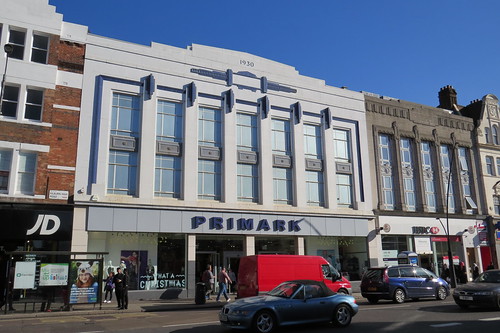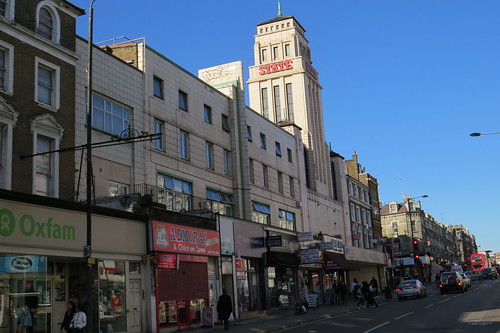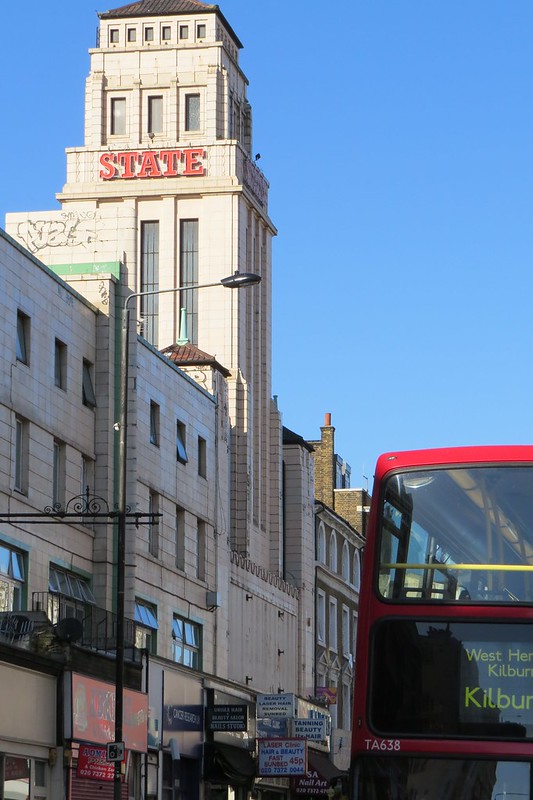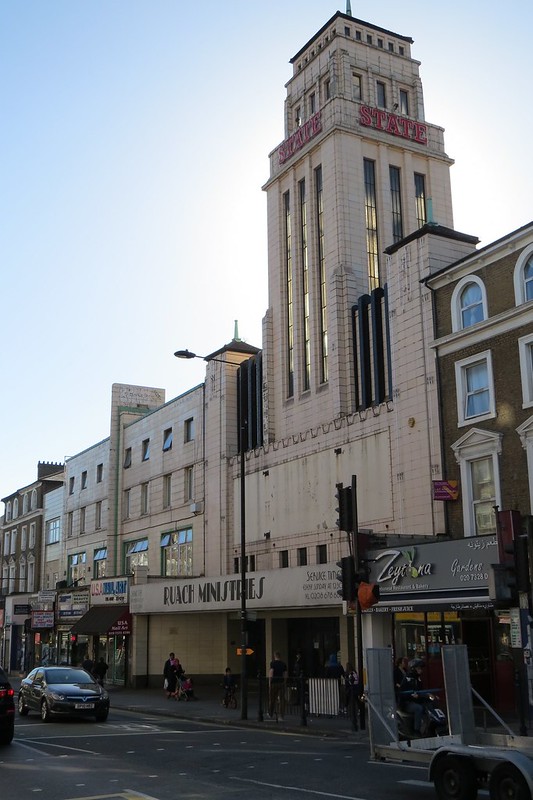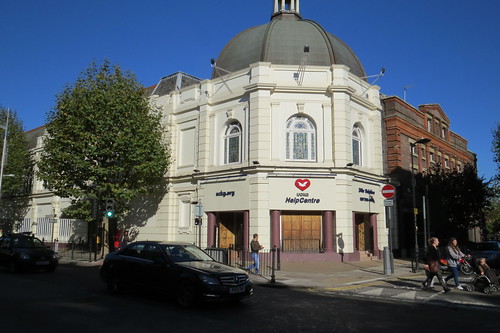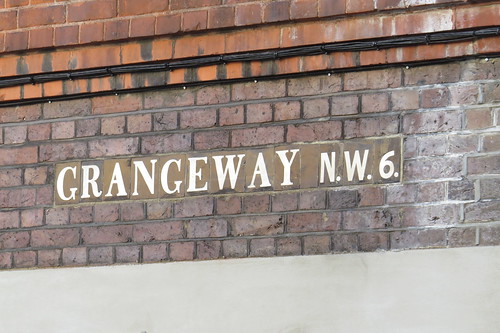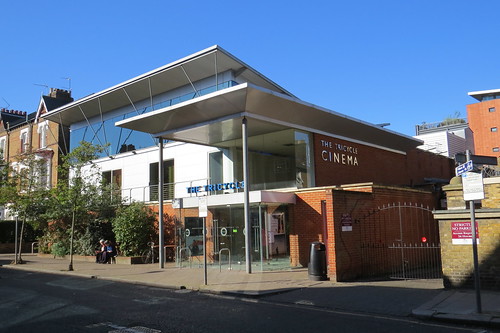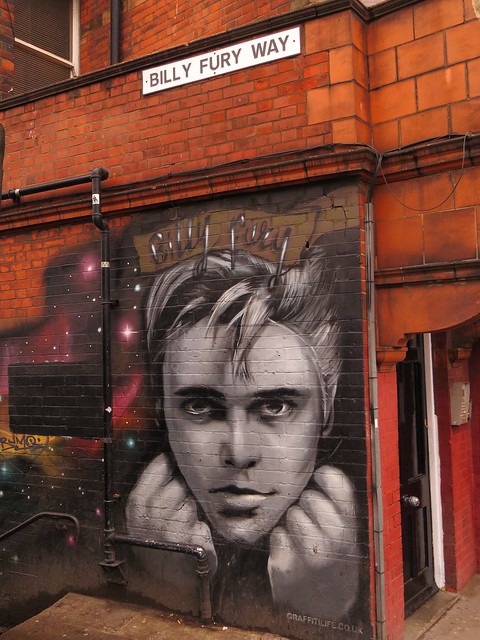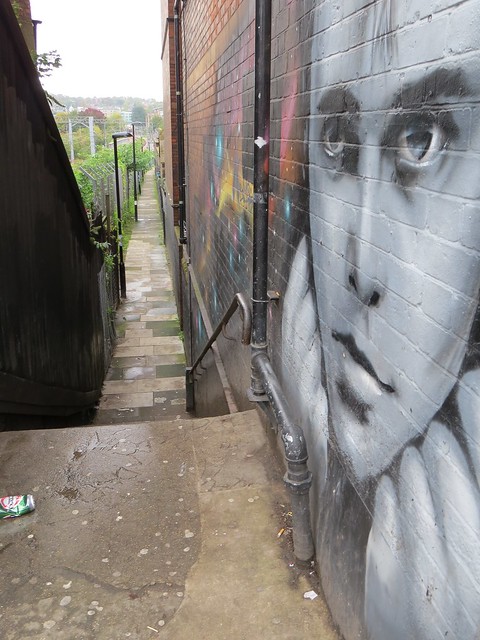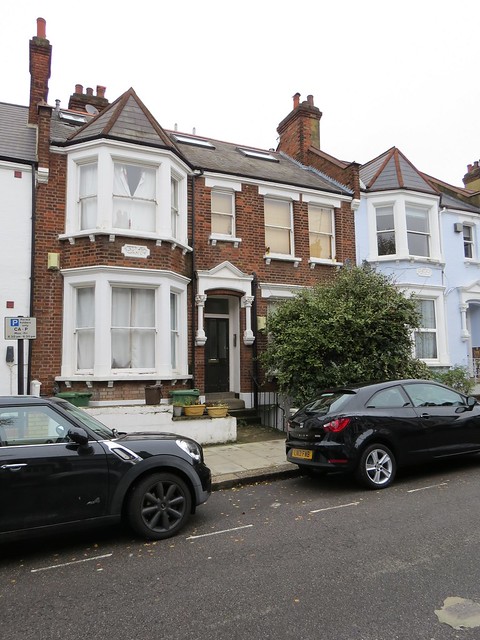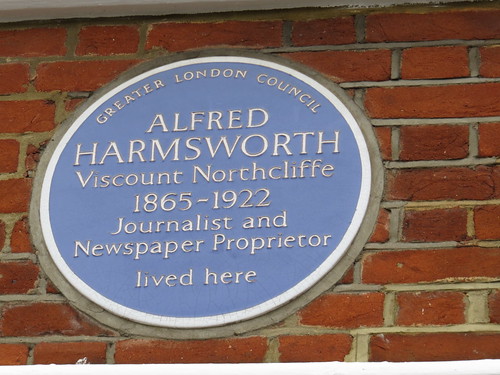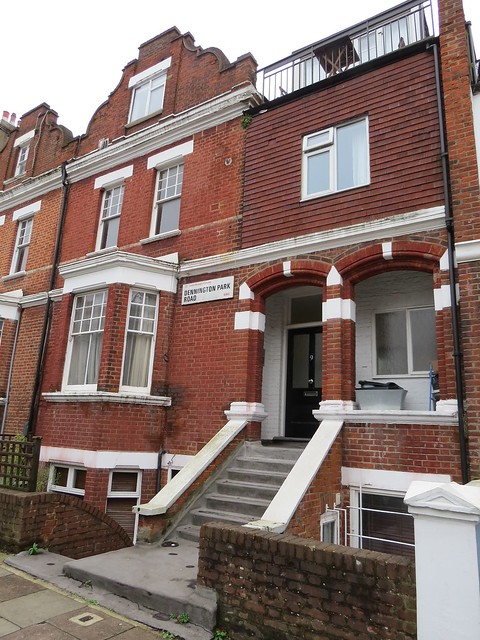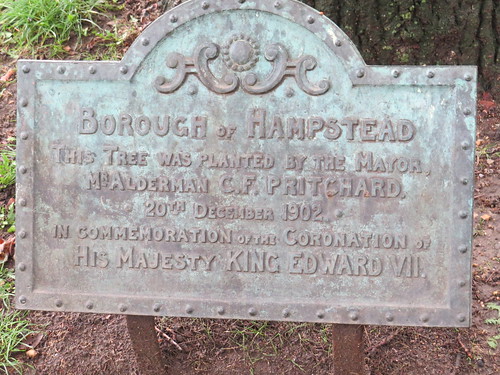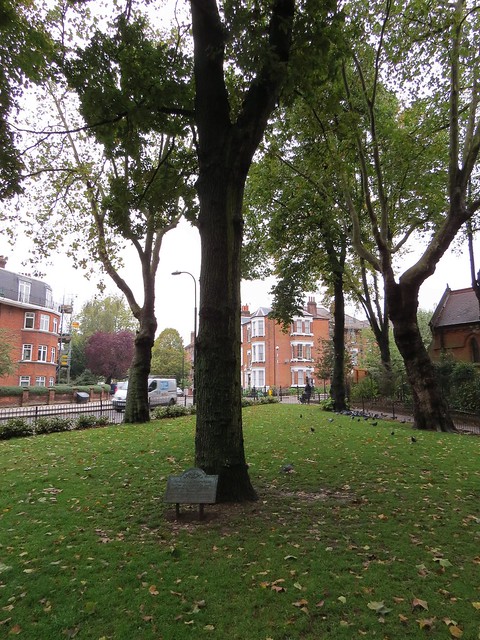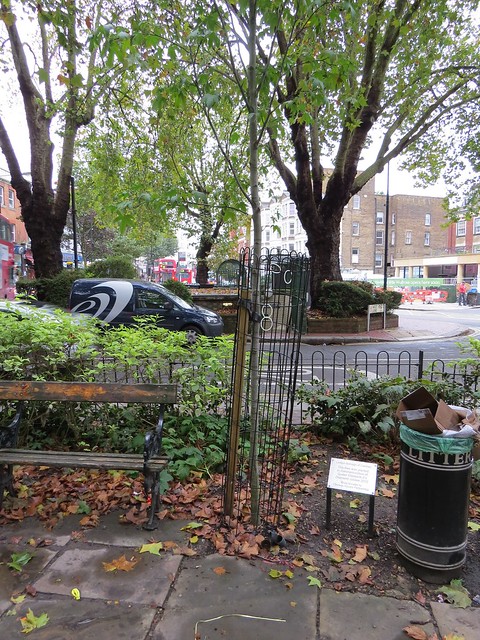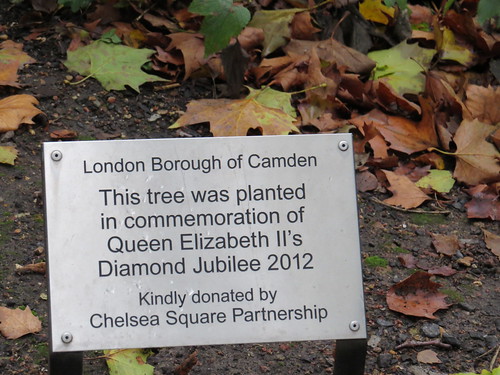NW6 is Kilburn – and West Hampstead. And we are going to have a look at both. Thanks by the way to fellow Westminster guide Rhona who lives in the area and drove me round NW6 and showed me the sights – in fact far more than I could possibly cover.
We start our walk at Kilburn Post Office whose address is 79a Kilburn High Road but which is actually is a side street called Brondesbury Villas. Take a left out of the Post Office and then left onto the High Road.
This is another street which was clearly a more important shopping centre once but which has not managed to get (or keep) the big names. Look at these two shops which are just near the Post Office. Clearly someone thought it worthwhile to invest in imposing facades in the inter war period.
(I think the HSBC building was once a Burton’s. It has that distinctive look.)
Walk along Kilburn High Road, and just before Willesden Lane on the left, the former Gaumont State cinema with its distinctive tower looms up.
Stop 1: Former Gaumont State cinema
The wonderful Cinema Treasures site says that the Gaumont State Theatre was the largest movie palace ever built in England and the third largest in the United Kingdom. The theatre opened just before Christmas 1937 and had a 4,004 seating capacity, split between a 1,356 seat balcony and stalls which seated 2,648.
According to Allen Eyles book ‘Gaumont British Cinemas’, the ‘State’ name and 120 foot skyscraper tower that adorns the facade were in tribute to the Empire State Building, New York which had opened just a few years earlier. The Gaumont State’s American Deco-inspired exterior is a sharp contrast to its green Italian Renaissance interior, which was perhaps was rather ‘old fashioned’ by comparison.
This building has had a chequered history with parts being used as a dance hall and a bingo hall. The main auditorium cinema closed in 1980 but a smaller screen in the former restaurant area carried on for a little longer, but with a gap between 1981 and 1985 and finally ending in 1990. Bingo carried on until 2007. In January 2008, the building was purchased by a church, and is now operated by the Ruach Ministries Church.
It was designated a Grade II Listed building on 10th October 1980 and has now been upgraded to a Grade II*.
More information on this cinema at: http://cinematreasures.org/theaters/1478
Continue walking along the High Road and soon on the other side of the road on the corner of Messina Avenue is another giant former cinema,
Stop 2: Former Grange Cinema
This cinema is a lot older that the Gaumont State, dating from 1914. It is remarkable forerunner of those super cinemas of the interwar period in terms of size (with around 2000 seats) and yet in terms of style it harks back to an older period).
The cinema’s name can be found in a couple of place on the upper section of the facade facing the High Road. It has a corner entrance topped by a large copper dome. Inside the foyer is a galleried oval rotunda with a stairway leading to what was the tea room and into the circle. You can peek in and see this lovely entrance way from the street.
This is an odd name for a cinema and relates to the fact that just about here was a house called Kilburn Grange, and running to the side and behind the cinema is a street called Grangeway as a further reminder.
The Grange Cinema was taken over by Gaumont British Theatres in 1929 who also in due course owned the State just over the road. The cinema closed in June 1975 and was converted into a nightclub which opened on 23rd February 1976. Initially called Butty’s, it later became the National Ballroom, and then a live music venue named the National Club which catered for the large Irish community in the area. The National Club closed in spring 1999. The building was empty and unused for several years, until it became a church. It is now operated by the Brazilian based ‘United Church of the Kingdom of God’.
It seems these days, evangelical churches is the saviour of many of these buildings now that bingo seems to be in decline. I do wonder though whether someone ought to try and run one of these as a cinema as a not for profit outfit with a varied programme of offbeat and vintage films maybe – possibly this is something the National Trust should look at if they could acquire the right building.
The building is Grade II Listed. Again lots of information about this old cinema on the cinema treasures site:
http://cinematreasures.org/theaters/21111
keep walking along the High Road and soon on the left you will see Buckley Road and the entrance to the Tricycle Cinema
Stop 3: Tricycle Theatre and Cinema
The Tricycle is a bit of a Kilburn institution. The Theatre on the High road started out as the Foresters Hall – the signage still proclaims “The Ancient Order of Foresters Friendly Society”. According to their website, The Ancient Order of Foresters today trades as Foresters Friendly Society. It was established in 1834, although its origins lie in a much older society called the Royal Foresters, formed around 1745. Their first members came to recognise they had a duty to assist their fellow men who fell into need “as they walked through the forests of life”. They also seem to have had lodges like the masons, of which I guess this was one.
The building was at some point converted to a music and dance hall. The Tricycle took it over in 1980 and this became the permanent home of the Wakefield Tricycle Company – a touring theatre company which presented new plays and children’s theatre throughout Britain and internationally. According to the Tricycle website, they never actually played Wakefield.
They always put on interesting and different stuff. I can perhaps do not better than quote from their website:
“The Tricycle views the world through a variety of lenses, bringing unheard voices into the mainstream. It presents high quality and innovative work, which provokes debate and emotionally engages. Located in Brent, the most diverse borough in London, the Tricycle is a local venue with an international vision.”
The purpose built cinema was added in 1998 with it own entrance in Buckley Road. Apparently the design on the screen curtain is unique to this cinema. It is in the form of a tricycle which upon closer inspection is made up of names of sponsors, patrons and film stars who have given their support to the cinema.
Retrace your steps back down the High Road and turn left into Messina Avenue. Follow this all the way along ( a bit of a trek, I am afraid) and turn left when you reach West End Lane. Soon on the left you will come to our next stop.
Stop 4: St James’ Church
This is a vast Victorian red brick barn of a church built in the 1880s by Arthur Blomfield – a prolific church architect. Normally these places are deserted in the week and often on Sundays too, but this one has found some interesting new uses. Walk down the side street (Sherriff Road) almost the full length of the church and go in the entrance.
Inside at the back in a Post Office counter, and with this at your back you have some counters of cards and postal items, to the right is a cafe and to the left an extensive children’s play area.
And there are plenty of people. Perhaps not what traditionalists would want to see but at least the building is performing useful community functions.
Now return to West End Lane and cross over and go down the street opposite (Broadhurst Gardens).
Stop 5: Number 165 Broadhurst Gardens (Former Decca Recording studios)
Almost immediately on your right is our next stop. This is currently used by English National Opera but for most of its life it was the main recording studios for Decca.
The name “Decca” originally comes from a portable gramophone called the “Decca Dulcephone” patented in 1914 by musical instrument makers Barnett Samuel and Sons. The name was coined by Wilfred S. Samuel by merging the word “Mecca” with the initial D of their logo “Dulcet” or their trademark “Dulcephone”.
“Decca” was a good brand name as it was easy to pronounce in most languages. That company was eventually renamed The Decca Gramophone Co. Ltd. and then sold to former stockbroker Edward Lewis in 1929 who built up the company. Lewis established an American Decca label in 1934 with others but the two companies went their separate ways during World War II. However the link was later re-established in 1998 when they ended up being owned by the same company (now Universal Music Group own both labels).
This building started off life as an engineering works and was converted into a recording studios by Crystalate Records in 1933. That company was acquired by Decca in 1937, and this building became Decca’s main London studio. The studios finally closed in 1980. There are some great pictures and detail about the studios on this link http://www.philsbook.com/decca.html
Probably the most famous story associated with the studios is of the Beatles audition. Brian Epstein paid Decca to provide a one hour audition for The Beatles at these studios on 1 January 1962. But they were turned down y Decca. Decca’s A & R Man at the time, Dick Rowe, is said to have told their manager, “Guitar groups are on their way out, Mr. Epstein”. Rowe later signed The Rolling Stones following an introduction and encouragement from George Harrison.
Now return to West End Lane and turn right. Almost immediately is the first of three stations which come in quick succession.
Stop 6: Three stations in quick succession
It is a curious quirk of London geography that most of the main railways lines to the midlands and north actually head west for a time as they pass through NW6. And here we have two of them in close proximity together with a third more local line.
The first station you come across is West Hampstead’s Jubilee line station.
This was actually built by the Metropolitan Railway in 1879 as it started to spread extend out from Baker Street. Initially the station acted as a temporary terminus until it was further extended to Willesden Green in November 1879. Later the lines were used by the Great Central Railway to get to its new London terminus Marylebone which opened in 1899. But soon extra tracks were needed for both the Metropolitan and Great Central services, although I think the latter just passed through here, without stopping.
In 1939 stopping Metropolitan services serving this station were transferred to the Bakerloo line and it was then that the platform was rebuilt in the newish Underground style. However the original street level station building was retained which makes for an odd mix. This arm of the Bakerloo line transferred to form the Jubilee line when it first opened in 1979.
Then just 100m along the street is the next station which is served by London Overground. The line opened in 1860 but this station was only added in 1888. It was called West End Lane until its name was changed in 1975. It was served by the North London Railway and for many years you could get a train from here to Broad Street in the City
Then just another 100m along you find West Hampstead Thameslink,
The station was built by the Midland Railway on its extension to St. Pancras, to serve the newly developed area around the hamlet of West End. It opened on 1 March 1871, and was originally named West End for Kilburn and Hampstead. It was renamed several times: to West End in 1903; to West End and Brondesbury in 1904; to West Hampstead in 1905; West Hampstead Midland in 1950; and finally West Hampstead Thameslink on 16 May 1988 – the latter rename was following the reopening of the Snow Hill tunnel in the City allowing trains to run through to south London, beginning the cross-London link we know and love today.
There was a plan to link these three stations with a subway but I guess it proved too expensive, But the Thameslink station has been rebuilt with a new building on the side (like Cricklewood this station was denuded of buildings when the line was electrified in the early 1980s). Interesting the building is not over the tracks, nor is there the kind of over track development that was done at Fulham Broadway where a small shopping mall with multi screen cinema was created. Perhaps it was too expensive to build over 6 rather than 2 tracks, plus this is probably not the justification for such a commercial development here.
Our next stop is actually a little before you get to the Thameslink station.
Stop 7: Billy Fury Way
Almost opposite the Overground station is a little alleyway going down some steps. And if you look back from the way you have come you will see it has a mural on Billy Fury and in fact the alleyway is called Billy Fury Way.
Billy Fury (1940 – 1983) was an internationally successful singer in the late 1950s and early 1960s. He was born in Liverpool and his real name was Ronald Wycherley, which does not sound very rock and roll so you can see why he changed it, or rather he had it changed by his management. He was signed to Decca and he recorded much of his work at the local studios.
In 2010 Camden Council and the police concluded it would be a good idea to name some unnamed pathways in West Hampstead so people could tell the police where they were if a crime was committed there. The public were consulted and for this one they voted in favour of Billy Fury – second choice was Decca Way. The mural dates from July 2011 and here is a piece about its unveiling.
http://westhampsteadlife.com/2011/07/29/billy-fury-way-officially-opens/3200
Continue walking along West End Lane and take the first left after the Thameslink station. Our next stop is a little way down Sumatra Road on the right as you approach it.
Stop 8: Number 104 Sumatra Road
There is a story that this was for a time the childhood home of one Mary O’Brien, better known as Dusty Springfield.
She was actually born at Fordwych Road in NW2 which was a maternity home and her family home on her birth certificate is Lauderdale Mansions W9. But the attached links suggest she lived here as a small child.
http://www.dustyspringfield.org.uk/ltd_archives/images/stories/PDF/Getting/Dustys_Birth_Certificate.
Here is a link to a site called West Hampstead Life which explains (if you scroll down a bit) more about the Sumatra Road connection – not sure about the dates though, given what the other link says..
http://westhampsteadlife.com/2013/11/01/musicians-in-west-hampstead-and-kilburn/5071
This link cites lots of other West Hampstead musical connections, a couple of which I will mention later.
But since originally posting this, I was contacted by a man called Ron who said (and I quote word for word): “Sorry your wrong Dusty Springfield never ever lived at 104 Sumatra road west hampstead my wifes family lived in that house from the 1930s untill 1989 so who ever told you is wrong”. So looks like this is just a story.
Fascinating fact: She got the nickname “Dusty” for playing football with boys in the street. And her brother Tom was really called Dion, which actually sounds more the part than Tom.
Continue walking along Sumatra Road and turn right into Pandora Road
Stop 9: Number 31 Pandora Road
Just here on the right at number 31 is a house with a blue plaque. Unlikely as it seems this fairly modest house was the home of Alfred Harmworth, later Baron and then Viscount Lord Northcliffe. With his brother, Harold, he created a newspaper empire. They bought the Evening Standard (1894) plus various provincial newspapers and they created the Daily Mail (1896) and the Daily Mirror (1903). He was one of the pioneers of tabloid journalism.
I have not been able to find out when he lived here but it must have been fairly early on in his career. But it is kind of fitting he lived in Pandora Road given he is partly responsible for opening the Pandora’s box of tabloid journalism!
Keep walking along Pandora Road. At the junction with Holmdale Road take a short detour to the right down Holmdale Road to the junction with Dennington Park Road. I am going to cover two more places identified in the West Hampstead Life musical connection blog.
Stop 10a: Number 9 Dennington Park Road
This was once the home of singer Olivia Newton John in around 1965. And according to the link under Sumatra road she was born in Cambridge England and only moved to Australia when she was 5.
This link also mentions Singer Robert Palmer lived in a basement flat in Dennington Park Road in 1972. Robert moved out of after the flat was flooded, destroying most of his belongings. But don’t know where.
Retrace your steps to the junction with Pandora Road but turn right into Inglewood Road.
Stop 10b: Number 12a Inglewood road
Just along here is another pop connection. Jimmy Somerville lived at 12a. This is mentioned in Part 2 of the West Hampstead life piece on musical connections.
http://westhampsteadlife.com/2013/11/19/musicians-in-west-hampstead-and-kilburn-part-two/5070
Also in this road at an unspecified address the American singer Loudon Wainwright III in 1986. There are lots of other pop connections so you can do you own walk from these two posts, although I warn you some of the addresses do go over the border into NW2!
Continue along Inglewood Road to the end and turn left. Our next stop is just ahead on the other side of the road.
Stop 11: West End Green
This little green was the centre of the old settlement here and has somehow survived.
There are a couple of commemoration trees – the older one is for the coronation of Edward VII in December 1902
and the other for the Queen’s Diamond Jubilee in 2012.
At this green, the main road becomes Fortune Green Road but West End Lane continues off to the right. Go along there and take the first turning on the left (Canon Hill)
Stop 12: Marlborough Mansions, Canon Hill (Sir Adrian Boult)
Having majored on pop music I had to include a classical connection. Just a short distance along Canon Hill is our next stop where you will see a blue plaque to the conductor Sir Adrian Boult who lived in Flat 78 between 1966 and 1977.
Boult set up the BBC Symphony Orchestra and was its principal conductor for some 20 years. Boult was known for his championing of British music.
He gave the first performance of Holst’s The Planets on 29 September 1918. Apparently Holst later wrote on his copy of the score, “This copy is the property of Adrian Boult who first caused The Planets to shine in public and thereby earned the gratitude of Gustav Holst.” What a great quote, eh?
He also introduced new works by, among others, Bliss, Britten, Delius, Tippett, Vaughan Williams and Walton and recorded extensively starting in 1920 to his last recording which was in 1978. A lot of his later recordings were for Decca and recorded at the Broadhurst Gardens studios.
So we have reached the end of our NW6 walk. It has had a kind of entertainment theme, from great cinemas through to various musicians and a recording studio. As ever there are always things I have missed out on. I did not time to explore the Irish connection which Kilburn is so well known for. I did not have time for the posher bits of NW6 – Brondesbury and Queen’s Park. Nor could I investigate the location of Kilburn Priory, the blue plaque to sculptor Gilbert Bayes (he did the Queen of Time sculpture over the main entrance of Selfridges) or the location of a house owned by John Spedan Lewis.
So for onward travel retrace your steps back along West End Lane and you have three stations to choose from. Plus of course local buses.
And once again thanks to Rhona for her local knowledge and chauffeuring skills.

